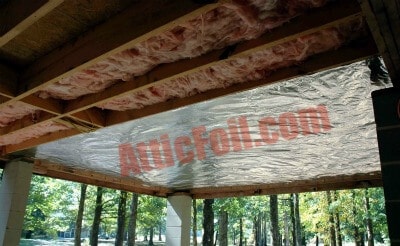2 thoughts on does radiant barrier damage roof shingles.
Radiant heat barrier attic shingle damage.
In cool climates.
Some studies show that radiant barriers can reduce cooling costs 5 to 10 when used in a warm sunny climate.
By installing a radiant barrier.
Savings equal the difference of the layer of foil blocking 97 of the radiant heat gain that you are currently allowing 100 of to enter the home.
The cooler a roof is the less radiant heat it emits.
Radiant barriers are utilized to reduce summer heat gain in attics and help to improve the efficiency of green building envelopes.
Radiant barrier is a way to get heat out of the attic for those of us that have a 25 to 30 year roof and are not looking to replace the roofing materials.
You cannot apply shingles directly on top of a radiant barrier product and still have a radiant barrier.
It is essentially intended to reflect radiant heat away from the attic.
One common question or concern about installing a radiant barrier is whether it will cause the shingles to heat up and get damaged or.
A radiant barrier reflects heat radiation radiant heat preventing.
We take a look at how radiant barriers work the different types of radiant barriers and some of the.
Florida solar energy center conducted a study on radiant barrier and shingle temperatures and found that the roof increased in temperature by only about 5 degrees at the hottest point of the day when the heat was entering and exiting the roof.
In theory if your roof never got any hotter than the outside air temperature then a radiant barrier would not be needed.
The roof absorbs radiant heat from the sun but air flow either wind or attic ventilation has a cooling effect on the roof and helps bring down the overall temperature.
The effect of radiant barriers on shingle temperatures.
The reduced heat gain may even allow for a smaller air conditioning system.
A radiant barrier is a type of building material that reflects thermal radiation and reduces heat transfer because thermal energy is also transferred by conduction and convection in addition radiation radiant barriers are often supplemented with thermal insulation that slows down heat transfer by conduction or convection.
Radiant barriers are more effective in hot climates than in cool climates especially when cooling air ducts are located in the attic.
The radiant barrier reflects 95 of the radiant heat back to the roofing materials which then emits over 90 of the heat out the roof almost instantly.
This is a valid concern based on the concept of what a radiant barrier is designed to do.
Our radiant barrier will greatly reduce the radiant heat that builds up in your shingle roof from penetrating into your attic and taxing your hvac system.
A radiant barrier can lower heat transfer from attics to the building below keep the attic space cooler and lower cooling costs by up to 17 in warmer climates.
By using the ventilation already installed in your attic or we can help with that too the radiant barrier forces the hot air out faster to bring cooler air into your attic through soffit vents.
Both upward to the sky and downward into the attic.

